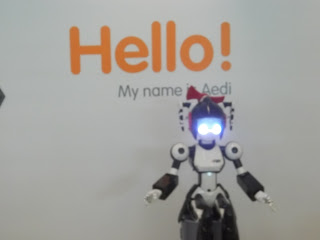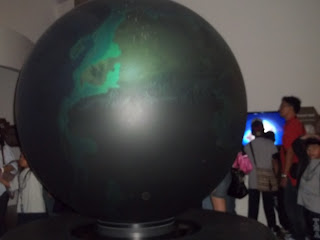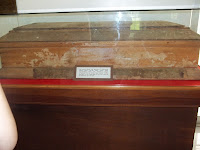I’ve been staying on my aunt’s house In Taguig ever since I was a first year student, and I was aware of places like Market! Market! And St. Lukes Medical Center in Global City, but recently, I visited another place which makes The Fort stand out from other innovation places in our country – The Mind Museum.
I went with my blockmates to enter for the morning shift from nine in the morning to twelve noon. When you see the museum from outside, it doesn’t look like a museum at all. Normally, museums have Greek columns and huge statues outside. Yet it means that this museum is in modern style, manifesting technology and innovation. The doors in the entrance are running through sensors.
Outside the museum
The tour starts in the lobby where a robot named Aedi greets all of the visitors, introduce the tour guides and the facilities inside the museum. All of the tour guides ride in a rover scooter. There are five galleries in the museum – the Atom, Earth, Universe, Life and Technology.
Aedi, the welcoming robot
a tour guide riding a rover scooter
We first visited the Earth gallery and the first thing to feast our eyes is the skeleton of a Tyrannosaurus-Rex. A spherical screen displays the surface of the Earth according to the timeline that you want and a part where you can experience fossil digging. The process of fossilization and different fossilized beings, like trilobites and leeches in rocks and insects in amber are also featured. A 3D short clip about the natural history of Earth is also for showing for all visitors.

The T-REX skeleton
The spherical screen of Earth's timeline
I am fossil digging, :))
Examples of fossils
The 3D documentary
The next gallery we visited is the Life gallery. First to catch our attention is the life-sized model of a whale shark or what we call as “butanding”. Another thing to mention is the different models of the human sense organs, parts of a cell, the DNA structure, a magnification of different insects and materials, and models of pre-historic man. It also features the human brain – its parts, its functions, and how it works.
The life-sized "butanding"
pre-historic man models
The human brain
parts of a cell
insects, a closer look
Next is the Astronomy gallery. It displays things found and used in space like the complete astronaut suite, the space radio, a remote controlled lunar roving vehicle – the moon buggy, and different documentaries about how the concepts about gravity were discovered. The ceiling of it portrayed the vast universe made up of millions of stars. Different planetary models are also featured. A planetarium is also open to its visitors.
The ceiling of the Astronomy gallery
an astronaut's suit
The Atom gallery is our next destination. Here we found different things related to Chemistry and Physics. There were big models of cyclohexanes and test tubes. A dome is decorated with different molecular structures of different compounds like Paracetamol, Acetone, Ethyl Alcohol, Glucose and Caffeine. A globe can transfer static electricity to the person who will hold it and will make that person’s hair stand out. Some models depict the concepts of sound waves and kinetic energy.
Chemical structures for paracetamol and acetone
The static electricity sphere
Last gallery, which is situated on the second floor of the museum, is the Technology gallery. This gallery features the applications of science and technology to the improvement and development in human life. Models of different vehicles from carts, junks and galleons from modern versions of cars and cruise are displayed.
The tour continued to the Science-in-the-Park, a park outside the museum where you can still enjoy the concepts of science. Sound domes, bubble tubes, and visual views of different animals like shark, eagle and cobra are some features in the park that I most enjoyed. The slides and seesaws brought us back to our childhood and made us enjoy the park even more.
You can see how these animals see its surroundings. :)
Seesaw & slides. :)
This is the best museum that I had visited, so far. Compared to other museums, this place portrayed the modern technology the best. Hopefully, more museums like this will rise so that it can be open to anyone so that all can experience how exciting science and technology can be.























































